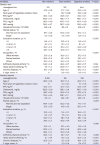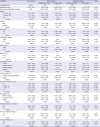1. The International Cadmium Association. Information about Cadmium. Accessed June 25, 2019.
http://www.cadmium.org/.
4. Lee MS, Park SK, Hu H, Lee S. Cadmium exposure and cardiovascular disease in the 2005 Korea National Health and Nutrition Examination Survey. Environ Res. 2011; 111(1):171–176.


5. Navas-Acien A, Selvin E, Sharrett AR, Calderon-Aranda E, Silbergeld E, Guallar E. Lead, cadmium, smoking, and increased risk of peripheral arterial disease. Circulation. 2004; 109(25):3196–3201.


6. International Agency for Research on Cancer. Cadmium and cadmium compounds. IARC Monogr Eval Carcinog Risks Hum. 1993; 58:119–237.


7. Nawrot TS, Martens DS, Hara A, Plusquin M, Vangronsveld J, Roels HA, et al. Association of total cancer and lung cancer with environmental exposure to cadmium: the meta-analytical evidence. Cancer Causes Control. 2015; 26(9):1281–1288.


8. Friberg L, Elinder C, Kjellstrom T, Nordberg GF. Cadmium and Health: a Toxicological and Epidemiological Appraisal Volume 1: Exposure, Dose, and Metabolism. Boca Raton, FL: CRC Press;1985.
10. US Food and Drug Administration. Harmful and potentially harmful constituents in tobacco products and tobacco smoke; established list. Fed Regist. 2012; 77(64):20034–20037.
11. Wagner KA, Flora JW, Melvin MS, Avery KC, Ballentine RM, Brown AP, et al. An evaluation of electronic cigarette formulations and aerosols for harmful and potentially harmful constituents (HPHCs) typically derived from combustion. Regul Toxicol Pharmacol. 2018; 95:153–160.


13. Margham J, McAdam K, Forster M, Liu C, Wright C, Mariner D, et al. Chemical composition of aerosol from an e-cigarette: a quantitative comparison with cigarette smoke. Chem Res Toxicol. 2016; 29(10):1662–1678.


15. Goniewicz ML, Knysak J, Gawron M, Kosmider L, Sobczak A, Kurek J, et al. Levels of selected carcinogens and toxicants in vapour from electronic cigarettes. Tob Control. 2014; 23(2):133–139.


16. Kim Y. The Korea National Health and Nutrition Examination Survey (KNHANES): current status and challenges. Epidemiol Health. 2014; 36:e2014002.

18. Elinder CG, Friberg L, Lind B, Jawaid M. Lead and cadmium levels in blood samples from the general population of Sweden. Environ Res. 1983; 30(1):233–253.


19. Järup L, Berglund M, Elinder CG, Nordberg G, Vahter M. Health effects of cadmium exposure--a review of the literature and a risk estimate. Scand J Work Environ Health. 1998; 24:Suppl 1. 1–51.
20. Prokopowicz A, Sobczak A, Szuła-Chraplewska M, Ochota P, Kośmider L. Exposure to Cadmium and Lead in Cigarette Smokers Who Switched to Electronic Cigarettes. Nicotine Tob Res. 2019; 21(9):1198–1205.


21. Zheng L, Wu K, Li Y, Qi Z, Han D, Zhang B, et al. Blood lead and cadmium levels and relevant factors among children from an e-waste recycling town in China. Environ Res. 2008; 108(1):15–20.


22. Lee B, Ha J. The effects of smoking and drinking on blood lead and cadmium levels: data from the fourth Korea national health and nutrition examination survey. Occup Environ Med. 2011; 68:Suppl 1. A93.

23. Godt J, Scheidig F, Grosse-Siestrup C, Esche V, Brandenburg P, Reich A, et al. The toxicity of cadmium and resulting hazards for human health. J Occup Med Toxicol. 2006; 1(1):22.


24. Kjellström T. Exposure and accumulation of cadmium in populations from Japan, the United States, and Sweden. Environ Health Perspect. 1979; 28:169–197.

25. Friberg L, Vahter M. Assessment of exposure to lead and cadmium through biological monitoring: results of a UNEP/WHO global study. Environ Res. 1983; 30(1):95–128.


26. Gaur S, Agnihotri R. Health effects of trace metals in electronic cigarette aerosols-a systematic review. Biol Trace Elem Res. 2019; 188(2):295–315.


27. Goniewicz ML, Knysak J, Gawron M, Kosmider L, Sobczak A, Kurek J, et al. Levels of selected carcinogens and toxicants in vapour from electronic cigarettes. Tob Control. 2014; 23(2):133–139.


28. Williams M, Villarreal A, Bozhilov K, Lin S, Talbot P. Metal and silicate particles including nanoparticles are present in electronic cigarette cartomizer fluid and aerosol. PLoS One. 2013; 8(3):e57987.

29. Farsalinos KE, Voudris V, Poulas K. Are metals emitted from electronic cigarettes a reason for health concern? A risk-assessment analysis of currently available literature. Int J Environ Res Public Health. 2015; 12(5):5215–5232.

30. Auer R, Concha-Lozano N, Jacot-Sadowski I, Cornuz J, Berthet A. Heat-not-burn tobacco cigarettes: smoke by any other name. JAMA Intern Med. 2017; 177(7):1050–1052.


31. Kim M. Philip Morris International introduces new heat-not-burn product, IQOS, in South Korea. Tob Control. 2018; 27(E1):e76–e78.









 PDF
PDF Citation
Citation Print
Print



 XML Download
XML Download